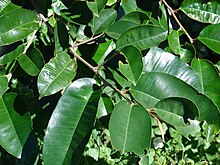Chrysophyllum
| Chrysophyllum | |
|---|---|
 |
|
| Chrysophyllum oliviforme | |
| Scientific classification | |
| Kingdom: | Plantae |
| (unranked): | Angiosperms |
| (unranked): | Eudicots |
| (unranked): | Asterids |
| Order: | Ericales |
| Family: | Sapotaceae |
| Subfamily: | Chrysophylloideae |
| Genus: |
Chrysophyllum L. |
| Synonyms | |
|
Achrouteria Eyma |
|
Achrouteria Eyma
Austrogambeya Aubrév. & Pellegr.
Cainito Adans.
Chloroluma Baill.
Cornuella Pierre
Cynodendron Baehni
Dactimala Raf.
Donella Pierre ex Baill.
Fibocentrum Pierre ex Glaz., nom. inval.
Gambeya Pierre
Gambeyobotrys Aubrév.
Guersentia Raf.
Martiusella Pierre
Nycterisition Ruiz & Pav.
Nycteristion Ruiz & Pav.
Prieurella Pierre
Ragala Pierre
Villocuspis (A.DC.) Aubrév. & Pellegr.
Chrysophyllum is a group of trees in the Sapotaceae described as a genus by Linnaeus in 1753.
The genus is native to tropical regions throughout the world, with the greatest number of species in northern South America. One species, C. oliviforme, extends north to southern Florida.
Chrysophyllum members are usually tropical trees, often growing rapidly to 10–20 m or more in height. The leaves are oval, 3–15 cm long, green above, densely golden pubescent below, from which the genus is named. The flowers are small (3–8 mm), purplish white and have a sweet fragrant smell; they are clustered several together, and are hermaphroditic (self fertile). The fruit is edible; round, usually purple skinned (sometimes greenish-white), often green around the calyx, with a star pattern in the pulp; the flattened seeds are light brown and hard. The fruit skin is chewy like gum, and contrary to some reports, is edible.
...
Wikipedia
